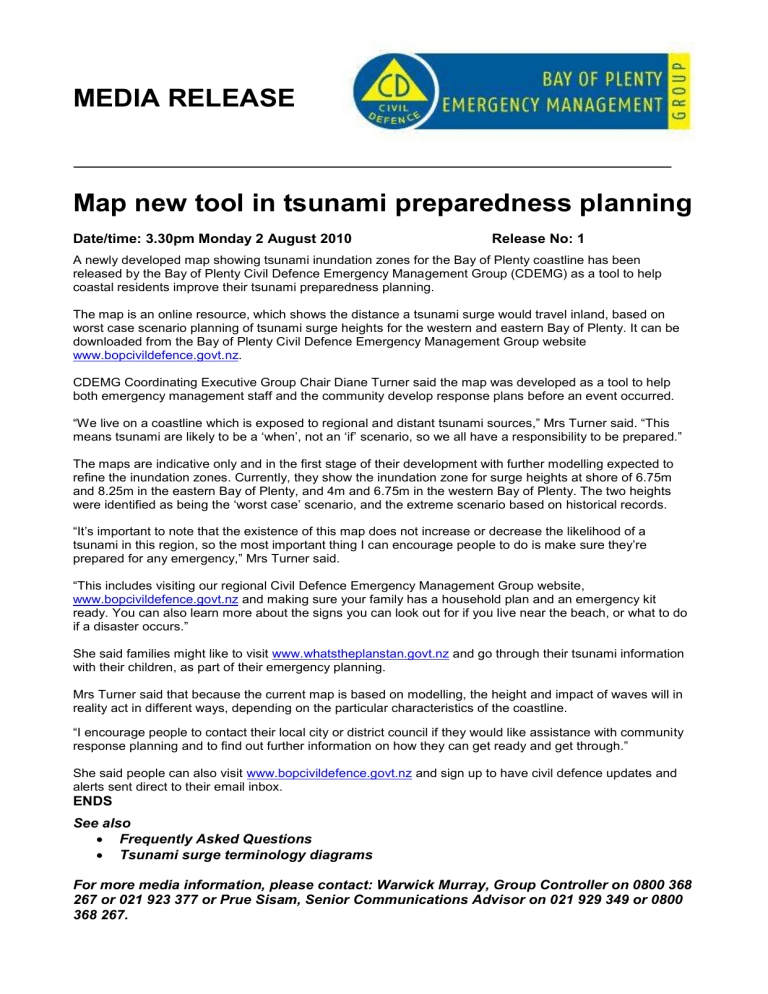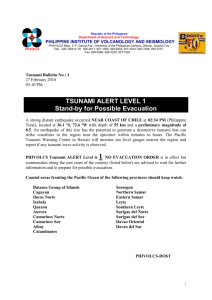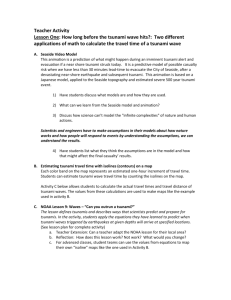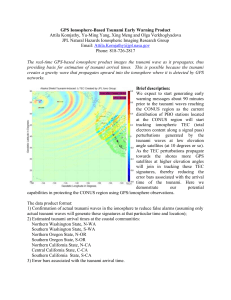Map new tool in tsunami preparedness planning

MEDIA RELEASE
Map new tool in tsunami preparedness planning
Date/time: 3.30pm Monday 2 August 2010 Release No: 1
A newly developed map showing tsunami inundation zones for the Bay of Plenty coastline has been released by the Bay of Plenty Civil Defence Emergency Management Group (CDEMG) as a tool to help coastal residents improve their tsunami preparedness planning.
The map is an online resource, which shows the distance a tsunami surge would travel inland, based on worst case scenario planning of tsunami surge heights for the western and eastern Bay of Plenty. It can be downloaded from the Bay of Plenty Civil Defence Emergency Management Group website www.bopcivildefence.govt.nz
.
CDEMG Coordinating Executive Group Chair Diane Turner said the map was developed as a tool to help both emergency management staff and the community develop response plans before an event occurred.
“We live on a coastline which is exposed to regional and distant tsunami sources,” Mrs Turner said. “This means tsunami are likely to be a ‘when’, not an ‘if’ scenario , so we all have a responsibility to be prepared.”
The maps are indicative only and in the first stage of their development with further modelling expected to refine the inundation zones. Currently, they show the inundation zone for surge heights at shore of 6.75m and 8.25m in the eastern Bay of Plenty, and 4m and 6.75m in the western Bay of Plenty. The two heights were identified as being t he ‘worst case’ scenario, and the extreme scenario based on historical records.
“It’s important to note that the existence of this map does not increase or decrease the likelihood of a tsunami in this region, so the most important thing I can encourage pe ople to do is make sure they’re prepared for any emergency,” Mrs Turner said.
“This includes visiting our regional Civil Defence Emergency Management Group website, www.bopcivildefence.govt.nz
and making sure your family has a household plan and an emergency kit ready. You can also learn more about the signs you can look out for if you live near the beach, or what to do if a disaster occurs.”
She said families might like to visit www.whatstheplanstan.govt.nz
and go through their tsunami information with their children, as part of their emergency planning.
Mrs Turner said that because the current map is based on modelling, the height and impact of waves will in reality act in different ways, depending on the particular characteristics of the coastline.
“I encourage people to contact their local city or district council if they would like assistance with community response planning and to find out further information on how they can get ready and get through.”
She said people can also visit www.bopcivildefence.govt.nz
and sign up to have civil defence updates and alerts sent direct to their email inbox.
ENDS
See also
Frequently Asked Questions
Tsunami surge terminology diagrams
For more media information, please contact: Warwick Murray, Group Controller on 0800 368
267 or 021 923 377 or Prue Sisam, Senior Communications Advisor on 021 929 349 or 0800
368 267.
FAQs
What does this map show?
The map shows an estimation of the level of inundation from maximum credible tsunami events (worst case and extreme case). It therefore also shows areas which should be safe from these events.
What will the map be used for?
It is intended the map be used as a basis for community response planning to ensure each community along the Bay of Plenty coastline understands its tsunami risk, and has plans in place to respond to natural and formal/informal warnings.
How did you determine this information?
Historical evidence and NIWA studies allowed an estimation of maximum and extreme credible events to be made. MCDEM and GNS Science have agreed that evidence suggests inundation may be twice the height of the tsunami at the mean high water mark. Further modelling will enable refinement of the inundation zones.
Will you be refining the maps further?
Yes, GNS will be engaged to conduct further tsunami modelling to allow the inundation zones to be refined.
This will also to allow modelling of tsunami impacts (debris volume, casualties, infrastructure and economic impacts) and enable pre-event recovery planning to occur. It will also allow the same to occur for greenfield sites where development is proposed.
How many tsunami events has the Bay of Plenty had?
Since 1840, tsunamis with height at shore of between 1m and 3m are known to have affected places along the Bay of Plenty and Eastern Coromandel coastline at least eleven times. Recent tsunami events have been small (<0.8m in height at shore) and are usually only detected by sea level gauges. Over the past
4000 years, a total of two major regional tsunami events have been recorded in sediment cores. One of these may represent two separate events. Sediment cores also reveal that up to four localised tsunami events have occurred in the Bay of Plenty during this time.
Will the map affect the value of my property/house?
Overseas studies have shown that maps like this will have minimal impact on property values.
Where can I get more information?
Tsunami information is available of the Bay of Plenty Civil Defence Emergency Management website
( www.bopcivildefence.govt.nz
) the Ministry of Civil Defence Emergency Management website
( www.civildefence.govt.nz
) or by contacting your local council emergency management officer. Local
Authority websites also have information on tsunami.
What’s our tsunami risk?
See question on number of tsunami events above.
Does this mean you’re going to put sirens along the coastline?
The Bay of Plenty Civil Defence Emergency Management Group is conducting a project to determine what the best alerting mechanism are for a range of hazard events, including tsunami. We are working closely with GNS Science and the Ministry of Civil Defence Emergency Management to determine what appropriate alerting mechanisms might be. Key to this is:
An alerting mechanism must have the ability to both alert and inform
A single alerting mechanism must have the ability to reach at least 70% of the target population
Tsunami information
What is a tsunami?
A tsunami is a natural phenomenon consisting of a series of waves generated when a large volume of water in the sea, or in a lake, is rapidly displaced. Tsunami are known for their capacity to violently flood coastlines, causing devastating property damage, injuries, and loss of life.
The principal sources of tsunami are:
Large submarine or coastal earthquakes, in which there is significant displacement of the seafloor or coast;
Underwater landslides (which may be triggered by an earthquake or volcanic activity);
Large coastal cliff or lakeside landslides;
Underwater volcanic eruptions.
Tsunami waves differ from ordinary coastal waves (see Fig. 2) in that the entire column of water, from the ocean floor to the surface is affected. Tsunami waves contain considerable energy. This means tsunami waves travel much further, both in coastal surges and retreats, compared to ordinary coastal waves.
Tsunami also create phenomena not characteristic of ordinary waves such as strong currents.
A tsunami can occur at any season of the year and at any time, day or night. On the open ocean tsunami waves are small and barely noticeable but when the waves enter shallow water they will rise in height. Some tsunami can be very large and can rapidly and violently inundate coastlines, causing loss of life and property damage.
Others can be small but still dangerous to those near or in the coastal water. It is important to remember that not all earthquakes will generate a tsunami, and that earthquakes are not the only sign of an impending tsunami so it is critical to know what to do as a precaution if you are in a vulnerable area.
What are our tsunami risks?
New Zealand’s entire coast is at risk of tsunami.
The biggest tsunami in New Zealand are likely to be caused by events close to our shore and can arrive within just a few minutes.
People on the beach or in low coastal areas need to be aware that a tsunami could arrive within minutes after a severe earthquake, without an official warning being issued.
In some cases, a relatively weak, rolling earthquake with a long duration can be followed by a large tsunami.
The tsunami danger period can continue for many hours after a major earthquake.
Tsunami also may be generated by very large earthquakes far away. Tsunami waves can travel thousands of kilometres and still be big enough when they arrive here to cause loss of life and damage.
A tsunami consists of a series of waves, and the first wave may not be the largest.
There may be many waves separated by up to an hour, or more.
Tsunami can travel around corners and inundate what appear to be sheltered areas.
All areas of the coastline will not be impacted equally. There can be a large variation in run-up and impact over short distances along the coast.
Tsunami waves can travel up streams and rivers with damaging waves extending farther inland than the immediate coast.
Once they travel over land, tsunami pick up debris, can knock down buildings and have enormous destructive force.
Harbours, bays and inlets often amplify tsunami waves.
Distant-, regional- and local- source tsunami
Definitions for the different sources of tsunami are:
NZ local sources: less than 1 hour tsunami travel time to the nearest New Zealand coastline, noting that many travel times are less than 30 minutes and some travel times are as short as a few minutes.
NZ regional sources: 1 –3 hours tsunami travel time to the nearest New Zealand coastline.
NZ distant sources: more than 3 hours of tsunami travel time to the nearest New Zealand coastline.
Tsunami terminology figures
Fig. 1 Tsunami waves are described by both their height and their run-up. Tsunami height is a measure of the vertical trough-to-crest height of a tsunami wave. Tsunami height is not constant – it increases substantially as the waves approach the shore and it depends on the near shore sea bottom configuration.
Fig. 2 Wave energy in ordinary coastal waves is limited to the surface of the ocean. This energy rapidly dissipates as the wave breaks on the shoreline (left). Energy in tsunami waves however, affects the entire column of water from the ocean floor to the surface (right). This energy does not readily dissipate. Instead, as the ocean floor rises, water is pushed upwards and much further inland releasing considerable energy and resulting in coastal inundation. A one metre tsunami wave cannot be likened to a one metre ordinary coastal wave.
Fig3 Scale of Tsunami wave against average person









